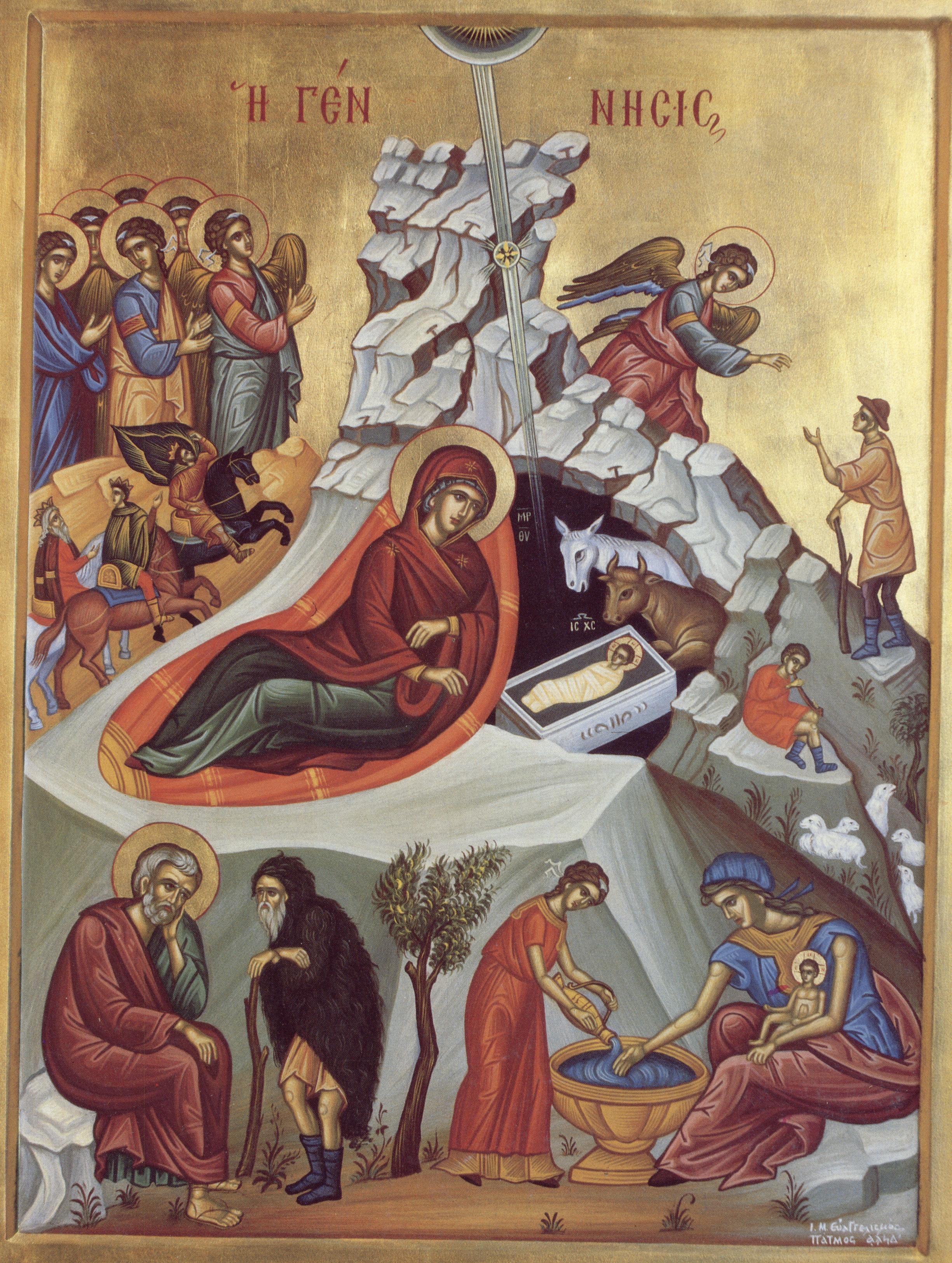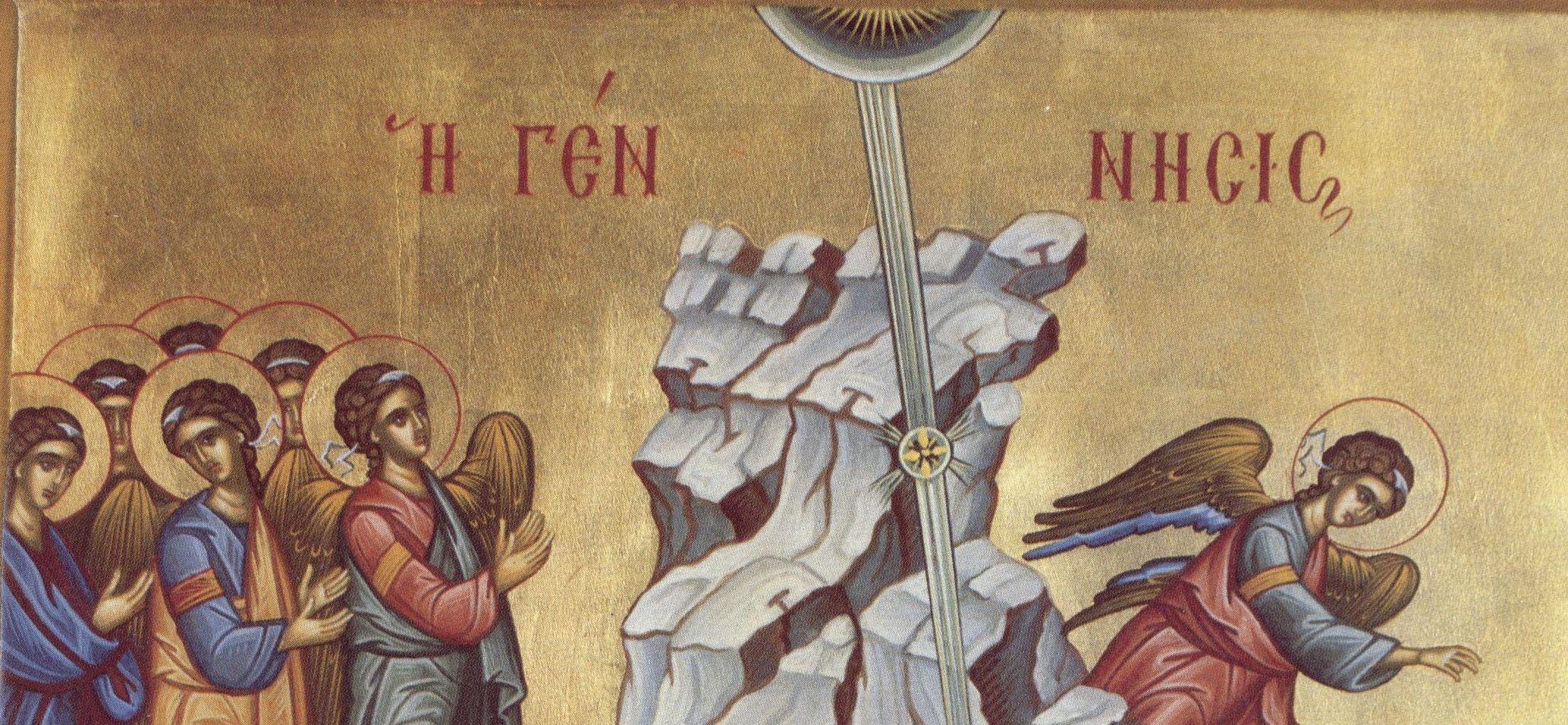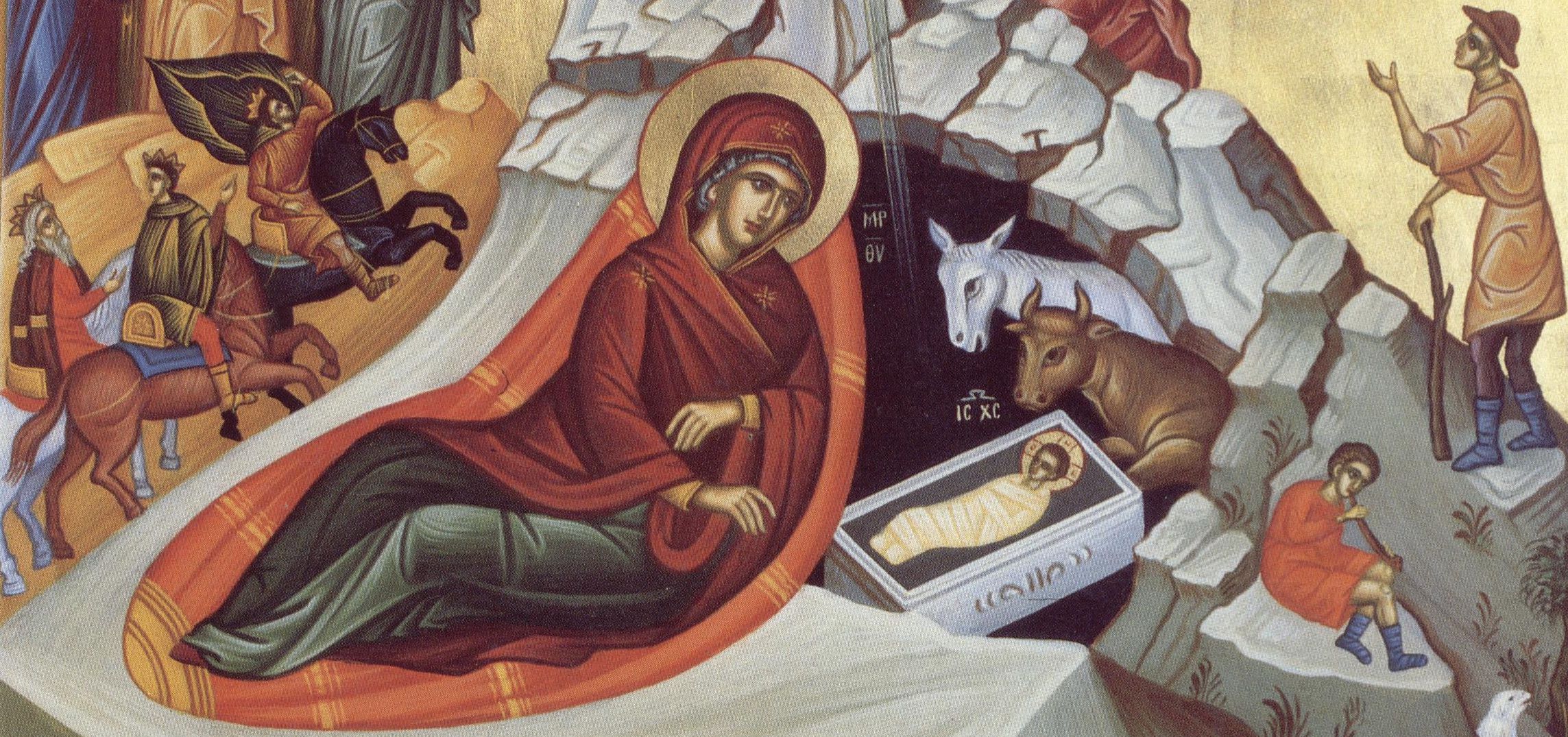 Originally celebrated with the Baptism of the Lord on January 6, the Feast of the Nativity is established by the Church in 354 for December 25. It is the feast of the re-creation of the world, after St. Gregory of Nazians, of the restoration of the fallen flesh. In the icon of the Nativity of the Lord the emphasis is put on three dogmatic aspects: God in moving down (kenosis); the miracle of the virgin birth (the creature begets its own Maker); the deification of man.
Originally celebrated with the Baptism of the Lord on January 6, the Feast of the Nativity is established by the Church in 354 for December 25. It is the feast of the re-creation of the world, after St. Gregory of Nazians, of the restoration of the fallen flesh. In the icon of the Nativity of the Lord the emphasis is put on three dogmatic aspects: God in moving down (kenosis); the miracle of the virgin birth (the creature begets its own Maker); the deification of man.
 The upper part of the icon signifies the theophanic and prophetic aspect
The upper part of the icon signifies the theophanic and prophetic aspect
The single radius descending from the semicircle located at the top of the icon represents the One Fate of God, but emerging from the star is divided into three to designate the Three People’s participation in the icon of salvation. Star is above a simple cosmic phenomenon, being sent by God to proclaim to the Magi the Highest Birth of a Heavenly Emperor, and at the same time guide them to the place where the miracle happened.
The austere mountain suggests the unpopular and hostile world after the fall of Adam and Eve and all of their descendants into sin. The sharp cliffs, illustrated like steps, seem to merge with the sky, indicating both God’s downward movement in man and man’s ascension to God, both possible with the moment of the Incarnation of the Second Person of the Holy Trinity. The whole earth seems to be joyful.
Angels are represented in their double work, doxology and proclamation. Some, generally the group on the left, are heading to the Light Spring, constantly praising God. The angel on the right bends over to the shepherds, giving them the birth of the King of Israel. The presence of angels testifies to the deity of the Child.
 The central part of the icon communicates the mysterious aspect of the incarnation
The central part of the icon communicates the mysterious aspect of the incarnation
The infant Jesus is represented either asleep or awake, looking at His Mother. The diapers in which He is wrapped are in the form of narrow strips, like funeral shrouds. His arms are joined on the chest in the image of the Cross, and the crib where the Child is placed has the appearance of a tomb-altar. All these predict the Death and Descent of Christ to hell. But “light shines in darkness, and darkness has not prevailed” (John 1, 5), because Christ will rise from the dead as an Almighty God.
The Mother of God is depicted sitting beside the infant Jesus, in front of the stallion, half leaning on a bed like the ones worn by Jews on their journeys. It has the red color, being illustrated as a royal bed, to suggest the honor to the Mother of God. Through this position of the Mother of God is iconographically affirmed the truth of the Nativity of the superficial, virgin, without pain, of Christ the Savior, which also emphasizes the deity of the Child. The three stars on the head and shoulders symbolize the virginity of the Mother of God before, during and after the Birth of Christ (everlasting). The expression of her face is a meditative one, with a conceited look – a grave attitude that anticipates the sufferings she will endure as the Mother of the One who would suffer death on the Cross for the salvation of the world. The Mother of God was the most exalted but mankind has ever been able to bring it to God.
The place of the birth of the Son of God was not an inn, but a place where the animals were kept. The Gospels do not mention the cave, but the iconographic representation finds its foundation in Tradition and liturgical texts. The dark openness of the cave in the middle of the sharp cliffs represents the fallen cosmos, the world overwhelmed by sin by the fall of man, as well as hell, the depths of darkness, which only He, the Sun of Justice, scatters with His birth. The cave and the manger are proofs of the deep humility of Christ the Savior.
Bull and ass are also not mentioned in the Gospel. Their presence with the infant Jesus (inspired by Matthew’s apocryphal gospel, chapter XIV) suggests the fulfillment of Isaiah’s prophecy: “The ox knows his master and the ass of his lord, but Israel does not know me; my people do not understand me. “(Isaiah 1: 3) The presence of animals also sends to the symbolism of the sacrificial calf and of the Assyrian of the King Who enters Jerusalem. In some Russian icons there appears a horse instead of the usual ass, unknown in Russia.
The shepherds are presented listening to the message of the angels. Often, one of them plays the whistle, thus adding the human art of singing to the choir of angels. They receive the first news of the wonderful Birth in the midst of daily activities, being, paradoxically, by their simplicity, closer to the heavenly world. The shepherds represent the first sons of Israel (the people chosen by God) who worship the Child, symbolizing the beginning of the Jewish Church, and the magicians the beginning of the Gentile Church.
The Magi are painted either on horses, on their way to Nativity, indicated by the star, or bringing gifts to the infant, golden, incense and myrrh, precious to the women bearing the ores, who came to the grave on Easter morning. The Magi gave gold, as for the King of the ages, incense, like to the One Who is the God of the universe and myrrh, as to the One Who died. The Magi are depicted in the image of three people of different ages, proving that Revelation is given to people regardless of their physical age, but to the extent of their spiritual level and their power of encompassing divine secrets. Magi are pagan peoples outside the chosen people. Though they are learned men, yet they have to go a long way toward knowing the True God. Their presence proves that the Church receives and sanctifies human science to the extent that it leads to the truth of faith, to the knowledge of God.
 The lower part of the icon depicts the human aspect of the Nativity of Christ
The lower part of the icon depicts the human aspect of the Nativity of Christ
The right Joseph appears in the left or right corner, down the icon, set apart by the Most Holy Virgin, an iconographic detail meant to highlight the Scriptural truth and the teaching of the Church that Christ was born of the Virgin, Joseph not being the father of the Child. His appearance must suggest an older man, Tradition saying he was 84 years old. It is represented with a halo, being among the righteous of God (Matthew 1, 19). Right Joseph has a meditative, worried expression, a state of disorder caused by Jesus’ virgin birth. Joseph conceives all the weak man in the faith, whose reason can not go beyond the limits of the realities seen, hence the difficulty of accepting the superficial reality of the mysteries of God. In the person of Joseph, the icon reveals not only his personal drama, but the drama of all mankind who looked at the mystery, not through the eyes of faith, but of limited reason. He is portrayed by listening to a figure representing the voice of illuminated reason.
The strange old man, clothed in an animal skin, leaning back from before Joseph, represents the deceiver Satan disguised as a shepherd who harasses Joseph with perfid questions. The scene is inspired by the apocryphal gospel of Jacob, which says that the wily man speaks through the shepherd of Thyrros: “Just as this rod (bent or broken, symbol of the crushed scepter of its former power, n.ed.) to give birth, so an old man like you can no longer conceive a babe, and a virgin can not bear “(but the rod immediately bloomed, n.ed.)
The infant bathing scene is based on passages from the apocryphal gospels of Jacob and Matthew, who speak of the presence of two women, Salomeea and Zelemi, called by Joseph to assist her in the birth of the Holy Virgin. The baby’s bathing scene has sparked a lot of controversy and discussion of the fairness of her representation, because the baby was totally clean and did not need washing. The Mother of God gave birth superficially without pain, the presence of the midwives being superfluous. Christ, through bathing, willingly accepted to obey a human custom, as he later wished to obey the practice of circumcision and baptism, which he did not need. This is also a testimony of the true incarnation of the Lord, which has become “just like the people willingly” (the Feast of the Feast, the Canon of St. John Damascene, the Fourth Song). Baptism at birth also prefigured Baptism in the waters of Jordan.
The icon of the Nativity of God transmits through its content itself the essence of the event, constituting as a witness of the fundamental dogma of the Christian faith: Incarnation of the Son of God. The icon highlights the effect of the incarnation of the Son of God on the whole creation, gaining a new meaning through transfiguration through the Holy Spirit as the ultimate goal of its existence.
All Romanian traditions mark the joy of the coming of Christ between us and in us through carols, songs and bright colors , in the clothes and the wearers of men shining the goodness and good cheerfulness brought by the blessing of God. With these spiritual beauties we will also decorate the icons of our souls.
